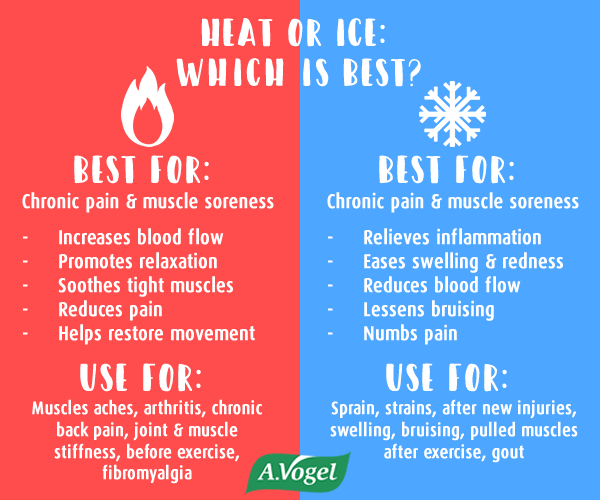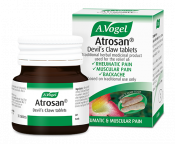Why do we turn to heat or ice?
Cold and heat therapies are an easy, natural and inexpensive ways to help relieve pain, so it’s little wonder they are so popular.
They are generally very efficient at their job, and understanding which is the best one to use for particular pains and aches can help you ease soreness, stiffness, swelling and inflammation faster, as well as prevent them from getting worse.
This handy graphic highlights the benefit of heat and ice and which is best to use for your pain or injury:

HEAT
Heat (also known as thermotherapy) allows blood vessels to dilate (open up), which stimulates blood circulation to help heal damaged tissues. Boosting blood flow to a painful area can also help to get rid of lactic acid waste build-up, which contributes to pain. The warmth also helps to relax sore muscles and ease muscle spasms and stiffness.
When to use heat:
Chronic problems
Apply heat to pains which have lasted for at least a week or for muscle and joint conditions that affect people’s lives for months or years, such as arthritis, fibromyalgia, sciatica or old injuries. Circulation in these conditions is often compromised because of scar tissue, compressed blood vessels or crushed nerves.
Back Pain
In a study which looked at the efficacy of thermotherapy (heat) and cryotherapy (ice) for pain relief for lower back pain, thermotherapy patients reported significantly less pain compared to cryotherapy.1
Another study found that continuous low-level heat wrap therapy was more effective than ibuprofen for treating low back pain.2
Muscle stiffness (without swelling)
Heat helps the muscles relax, improves circulation and reduces muscle spasms.
Joint pain and/or stiffness (without swelling)
Heat helps the tendons and ligaments improving flexibility, which helps ease joint pain and stiffness.
Injuries after the swelling has gone down
Heat relaxes the muscles in the area that may still be tense, improving flexibility.
Trapped nerves
Heat stimulates nerves and improves their blood supply.
Prior to physical activity
Applying heat before activity stimulates blood flow, warming up muscles and making tendons more flexible, which helps to reduce the risk of injury and ongoing problems.
How to apply heat:

There are many different ways heat can be applied including hot water bottles, heating pads, heated gel packs, heat wraps, wheat bags, heat creams and rubs, a warm shower, sauna or a long soothing hot bath. Even a hot, wet towel can bring relief.
The heat should be warm, not excessive. Don’t apply heat for longer than 20 minutes and protect your skin from burns or scalds by wrapping a thin towel around any heat source. Also never use a heating cream along with a heating pad or wrap.
Rub the pain away
If you are feeling stiff and sore, a warming muscle balm can give fast soothing relief. The warming effect of a rub or balm, together with the rubbing motion when apply can help ease sore muscles and aching joints.
Have a magnesium bath
Just soaking in warm water alone can help relax muscles and loosen stiff joints, but adding a magnesium soak to your bath can further relax your muscles. Magnesium plays an essential role in the healthy function of your muscles and joints and soaking it through your skin is considered to be the best way to obtain magnesium.
When should heat not be used?
Don’t use heat on a new injury or bruising; it can make it worse by increasing bleeding under the skin around the injured area. Heat therapy is also not usually recommended for people who have diabetes or some vascular conditions.
ICE
Ice (also known as cold therapy or cryotheraphy) constricts the blood vessels, which slows down blood flow to injured or painful areas. This helps to reduce swelling, redness, inflammation and although often uncomfortable at first, it can also numb pain.
When to apply cold/ice:
New injuries
Ice is most commonly used to treat new injuries, within the first 48 hours. It helps to control the inflammatory response, which reduces swelling and pain, as well as bruising. Ice is ideal for injuries such as sprains and strains.
Pain due to over-exertion
The pain experienced in the 12-48 hrs following over-exertion is due to many very small injuries to the muscle fibres or to the tendons that attach the muscles to the bones. Blood rushing to the area causes inflammation, redness and tenderness, therefore cold is used to reduce blood circulation.
After a hard work out
Icing after a workout can help prevent muscle soreness. It also helps lessen the wear and tear of muscles and joints, allowing you to recover faster.
General inflammation or tenderness
The swelling that occurs with inflammation is also accompanied by pain. Cold helps numb sharp pain and reduce inflammation.
Gout
Ice can help calm gout flare-ups and numb pain.
How to apply ice:

For injuries such as knee or ankle sprains the R.I.C.E method is recommended – Rest, Ice, Compress and Elevate. Rest it, put ice packs on it for 15-20 minutes several times a day, compress it with a wrap to help control swelling, then elevate it to help minimise swelling.
As a general rule never use ice for longer than 20 minutes at a time. Leaving ice on an injury for too long can reduce the blood flow to the injury and slow the healing process. If the problem gets worse or doesn’t show significant improvement in 48 hours, it is important to consult your doctor.
Also, don’t apply it directly to the skin. Use a cloth barrier to protect your skin from damage such as frostbite.
When should ice not be used?
Don’t apply ice to an open wound. It is also not advised to use ice if there is a risk of cramping. Ice can also make muscle tension and spasms worse.
Bottom line
A good rule of thumb is to consider the timing of the pain or injury. If it is new and there is pain, redness, inflammation and swelling then ice it. If it is an older, chronic problem or minor sore muscles then use heat.
What else can help soothe aches and injuries?
 Atrogel Arnica Gel
Atrogel Arnica Gel
Containing extracts of fresh Arnica flowers, our Atrogel Arnica Gel can help relieve stiff, sore joints and muscles, as well as inflammation causes from strains, sprains and pains. This easy-to-apply, non-greasy gel can be used up to 4 times a day.
 Arnica Skin Cream
Arnica Skin Cream
Arnica is a well-known go-to remedy for bruising. Our Arnica Skin Cream is a silky, lightweight cream which contains fresh extracts of arnica flowers, comfrey and chamomile and is suitable for the whole family.
1. https://www.ncbi.nlm.nih.gov/pmc/articles/PMC4225921/
2. https://www.ncbi.nlm.nih.gov/pubmed/12004166
Originally published 28 July 2015, updated 23 August 2018





 Looking for a treatment to relieve pain in conditions such as muscle aches or pains, stiffness, rheumatic pain or after sporting injuries?
Looking for a treatment to relieve pain in conditions such as muscle aches or pains, stiffness, rheumatic pain or after sporting injuries?

